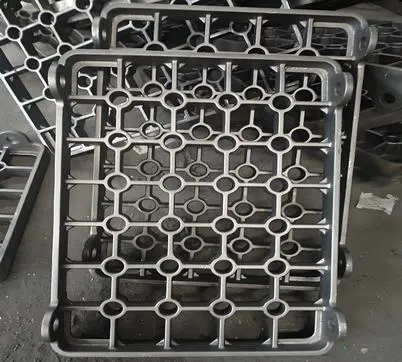Design Features of Base Trays for Heat Treatment Applications
Material Selection for Durability and Heat Resistance
The choice of materials for base trays is paramount in ensuring their longevity and performance in heat treatment environments. High-grade alloys, such as heat-resistant stainless steel or nickel-based superalloys, are often employed due to their exceptional thermal stability and resistance to oxidation. These materials maintain their structural integrity even when subjected to extreme temperatures, preventing warping or degradation that could compromise the tray's functionality. Additionally, the selected materials must exhibit low thermal expansion coefficients to minimize distortion during heating and cooling cycles, preserving the dimensional accuracy of the treated components.
Ergonomic Considerations for Handling and Transportation
Ergonomic design is a critical aspect of base tray development, as it directly impacts the ease of handling and transportation within heat treatment facilities. Trays are typically equipped with strategically placed handles or gripping points that allow for safe and efficient manual manipulation. The weight distribution of the tray is carefully balanced to reduce operator fatigue and minimize the risk of accidents during movement. Some advanced designs incorporate features that enable seamless integration with automated handling systems, such as robotic arms or conveyor belts, further enhancing workflow efficiency and reducing the need for manual intervention.
Customization Options for Specific Heat Treatment Processes
Base trays can be tailored to accommodate specific heat treatment processes and workpiece geometries. Customization options may include adjustable dividers, specialized fixtures, or modular inserts that can be reconfigured to support various component sizes and shapes. This flexibility allows heat treatment facilities to optimize tray utilization across different product lines, reducing the need for multiple tray types and simplifying inventory management. Some base trays feature perforated designs or mesh constructions that promote uniform heat distribution and facilitate rapid cooling when required, enhancing process control and cycle times.
Operational Benefits of Implementing Base Trays in Heat Treatment Workflows
Enhanced Process Consistency and Quality Control
The implementation of base trays in heat treatment workflows significantly contributes to process consistency and quality control. By providing a stable and uniform platform for workpieces, base trays ensure that components are exposed to consistent thermal conditions throughout the treatment cycle. This uniformity minimizes temperature gradients and reduces the risk of localized overheating or under-processing, which can lead to variations in material properties. The precise positioning of workpieces on base trays also facilitates accurate temperature monitoring and control, enabling operators to maintain tight process parameters and achieve reproducible results across production batches.
Improved Throughput and Cycle Time Reduction
Base trays play a pivotal role in improving throughput and reducing cycle times in heat treatment operations. The ability to batch-process multiple components on a single tray maximizes furnace utilization and increases overall productivity. Well-designed trays allow for rapid loading and unloading of workpieces, minimizing furnace downtime between cycles. Additionally, the use of base trays facilitates the implementation of automated handling systems, further streamlining the movement of materials through various stages of the heat treatment process. This automation not only reduces manual labor requirements but also enables continuous operation, potentially leading to significant improvements in production capacity and efficiency.
Enhanced Safety and Reduced Risk of Product Damage
The utilization of base trays in heat treatment facilities contributes significantly to workplace safety and product integrity. By providing a secure platform for transporting and handling workpieces, base trays reduce the risk of accidental drops or collisions that could result in operator injuries or damage to valuable components. The structured organization of parts on trays also minimizes the need for direct handling of hot materials, thereby decreasing the potential for burns or other heat-related accidents. Furthermore, the stable support offered by base trays protects delicate or precision-engineered components from deformation or surface damage that could occur during the heat treatment process, ensuring that the final products meet stringent quality standards.
Future Trends and Innovations in Base Tray Technology for Heat Treatment
Integration of Smart Sensors and IoT Capabilities
The future of base tray technology in heat treatment facilities is poised for significant advancements through the integration of smart sensors and Internet of Things (IoT) capabilities. These innovations will enable real-time monitoring of critical parameters such as temperature distribution, humidity levels, and even the structural integrity of the tray itself. By embedding sensors directly into the base trays, operators can gather valuable data throughout the heat treatment process, allowing for proactive maintenance, predictive quality control, and optimization of process parameters. The connectivity provided by IoT integration will facilitate seamless data exchange between base trays and central control systems, enabling more sophisticated process automation and adaptive control strategies.
Development of Advanced Materials for Extreme Conditions
Ongoing research in materials science is paving the way for the development of next-generation base trays capable of withstanding even more extreme conditions. Novel ceramic composites and advanced metal alloys are being engineered to offer superior heat resistance, chemical inertness, and mechanical stability at ultra-high temperatures. These materials promise to extend the operational limits of base trays, enabling heat treatment processes at higher temperatures and for longer durations. Additionally, the exploration of functionally graded materials and nanostructured coatings may lead to base trays with tailored thermal properties, optimizing heat transfer characteristics and energy efficiency in heat treatment applications.
Adoption of Additive Manufacturing for Customized Tray Production
The adoption of additive manufacturing technologies, such as 3D printing, is set to revolutionize the production of customized base trays for heat treatment facilities. This approach allows for the rapid prototyping and manufacturing of complex tray geometries that would be challenging or cost-prohibitive to produce using traditional methods. Additive manufacturing enables the creation of lightweight yet robust tray designs with optimized thermal characteristics, potentially incorporating internal channels for enhanced cooling or specialized support structures for unique workpiece configurations. The flexibility of 3D printing also facilitates on-demand production of base trays, reducing inventory requirements and enabling quick adaptation to changing production needs in heat treatment operations.
In conclusion, base trays are indispensable components in modern heat treatment facilities, supporting efficient workflows and ensuring high-quality outcomes. As technology continues to advance, the role of base trays in optimizing heat treatment processes is expected to grow, further enhancing productivity and precision in various industrial sectors. For more information on innovative base tray solutions and how they can benefit your heat treatment operations, please contact us at info@welongpost.com.
References
- Heat Treating Market Size, Share & Growth Report, 2030. (2024, December 31). Grand View Research.
- U.S. Heat Treating Market Size And Share | Report, 2024. (2024, December 31). Grand View Research.
- Thermal Loop Solutions, Part 1: A Path to Improved ... - Heat Treatment. (2025, February 11). Heat Treat Today.
- Full article: 3D printing driving innovations in extreme low ... (2025, February 6). Taylor & Francis Online.
- Heat Treatment of Metals: Processes and Benefits - MFG Shop. (2025, February 8). MFG Shop.
- Practical Heat Treating: Processes and Practices. (2024, April 30). ASM International.




